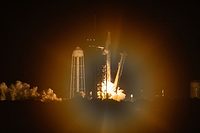Self-Cleaning Coatings for Space or Earth
Transparent Electrodynamic Dust Shields Usable for Solar Cells

Image courtesy of NASA.
Reducing dust accumulation on any surface is key for lunar missions, as dust can damage or impair the performance of everything from deployable systems to solar cells on the Moon’s surface. Electrodynamic dust shields (EDS) are a key method to actively clean surfaces by running high voltages (but low currents) through electrodes on the surface. The forces generated by the voltage efficiently remove built-up, electrically charged dust particles. Innovators at NASA's Kennedy Space Center have developed a new transparent EDS for removing dust from space and lunar solar cells, among other transparent surfaces.
 Examples of the EDS actively removing the dust from glass surfaces under vacuum when dust is placed by (A) a brush and (B) by a vacuum dust deposition system. Images courtesy of NASA.
Examples of the EDS actively removing the dust from glass surfaces under vacuum when dust is placed by (A) a brush and (B) by a vacuum dust deposition system. Images courtesy of NASA.
The new coatings operate at half the voltage of existing EDS while being 90% thinner. These capabilities are enabled by an innovative combination of electrode patterning and a thin silica protective layer. The reduced thickness and lower voltage operation expand possibilities for integrating EDS onto transparent surfaces across industries.
The Technology
The new transparent EDS technology is lighter, easier to manufacture and operates at a lower voltage than current transparent EDS technologies. The coating combines an optimized electrode pattern with a vapor-deposited protective coating of SiO₂ on top of the electrodes, replacing either polymer layers or manually adhered cover glass (see figure on the right). It has been shown to achieve similar performance — over 90% dust-clearing efficiency — to previous technologies while being operated at half the voltage.
The key improvement of the new EDS coating comes from an innovative method to successfully deposit a protective layer of SiO₂ that is much thinner than typical cover glass. Using vapor deposition enables the new EDS to scale more successfully than other technologies that may require more manual manufacturing methods. The EDS has been proven to reduce dust buildup well under vacuum and may be adapted for terrestrial uses where cleaning is done manually.
The coatings could significantly improve dust removal for solar cells in regions such as deserts, where dust buildup is inevitable but water access is limited. The EDS may also be applicable for any transparent surface that must remain transparent in a harsh or dirty environment.
The related patent is now available to license. NASA does not manufacture products itself for commercial sale.
This article first appeared in the August 2024 issue of Tech Briefs. For further information, click here.
Looking for a reprint of this article?
From high-res PDFs to custom plaques, order your copy today!






